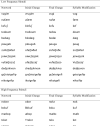Learning novel words: detail and vulnerability of initial representations for children with specific language impairment and typically developing peers
- PMID: 22225571
- PMCID: PMC3288194
- DOI: 10.1016/j.jcomdis.2011.12.003
Learning novel words: detail and vulnerability of initial representations for children with specific language impairment and typically developing peers
Abstract
This study examines the phonological representations that children with specific language impairment (SLI) and typically developing peers (TD) have during the initial process of word learning. The goals of this study were to determine if children with SLI attended to different components of words than peers, and whether they were more vulnerable to interference than peers. Forty 7- and 8-year-old children, half with SLI, took part in a fast mapping, word learning task. In addition to producing the word, there was a mispronunciation detection task that included mispronunciations of the target word in the initial position, final position or that modified the word's syllable structure. Children with SLI showed a different learning profile than peers, demonstrating stronger representations of the word-initial phonemes, but less information about word-final phonemes. They were more prone to interference overall, but especially from word-final foils. Children with SLI did not demonstrate less-defined phonological representations, but did attend to different features than TD children, perhaps in an attempt to compensate for problems learning longer words. The greatest weakness of children with SLI appears to be their susceptibility to interference, particularly for word-final information.
Learning outcomes: Readers will be able to: (1) explain what children attend to when learning new words; (2) state the pattern of recognition and production performance for both children with SLI and their typical language peers; and (3) identify specific parts of novel words that are most susceptible to interference in children with SLI.
© 2011 Elsevier Inc. All rights reserved.
Figures





References
-
- Alt M, Plante E. Factors that influence lexical and semantic fast mapping of young children with specific language impairment. Journal of Speech, Language, and Hearing Research. 2006;49:941–954. - PubMed
-
- Alt M, Plante E, Creusere M. Semantic features in fast mapping: Performance of preschoolers with specific language impairment versus preschoolers with normal language. Journal of Speech, Language, and Hearing Research. 2004;47:407–420. - PubMed
-
- Baddeley A. Working memory and language: An overview. Journal of Communication Disorders. 2003;36:189–208. - PubMed
-
- Baddeley AD, Thompson N, Buchanan M. Word length and the structure of short-term memory. Journal of Verbal Learning and Verbal Behavior. 1975;14:575–589.
Publication types
MeSH terms
Grants and funding
LinkOut - more resources
Full Text Sources

